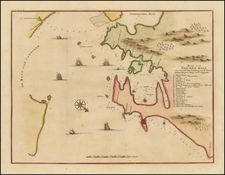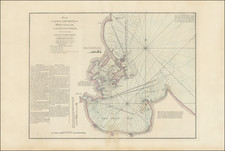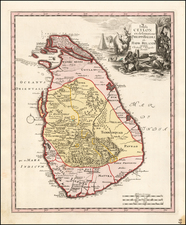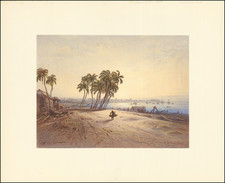Adam's Peak / Sri Lanka
Fine early image of the Sacred Mountain of Adam's Peak or Sri Prada in Sri Lanka.
Sri Pada is first mentioned (as Samanthakuta) in the Deepawamsa, the earliest Pali chronicle, (4th century), and also in the 5th century chronicle Mahawamsa, where it is stated that the Buddha visited the mountain peak. The chronicle Rajavaliya states that the King Valagamba (1st century BCE) had taken refuge in the forests of Adam's Peak against invaders from India, and later returned to Anuradhapura. The Mahawamsa again mentions the visit of King Vijayabahu I (1058–1114) to the mountain. The famous Chinese pilgrim and Buddhist traveler Fa Hien stayed in Sri Lanka in 411–12 CE and mentions Sri Pada although it is not made clear whether he actually visited it.
The Italian merchant Marco Polo in his Travels of 1298 CE noted that Adam's Peak was an important place of pilgrimage but did not mention a footprint in the rock.
The Arab traveler Ibn Battuta climbed to the summit of the mountain which he called Sarandīb in 1344 CE. In his description he mentions a stairway and iron stanchions with chains to help the pilgrims. The first ascent of the peak by an Englishman was made by Lieutenant William Malcolm of the 1st Ceylon Regiment on 26 April 1815, from the Ratnapura side. John Davy, brother of the noted chemist Sir Humphry Davy, visited the peak in 1817. He recorded observing an oversized foot print carved in stone and ornamented with a single margin of brass and studded with gems.
Adam's Peak is revered as a holy site by Buddhists, Hindus, some Muslims and Christians. It has specific qualities that cause it to stand out and be noticed, including its dominant and outstanding profile, and the boulder at the peak containing an indentation resembling a footprint. As noted in the Encyclopedia Britanica in 1910.
For a long period Sri Pada was supposed to be the highest mountain in Ceylon, but actual survey makes it only 7353 ft. above sea-level. This elevation is chiefly remarkable as the resort of pilgrims from all parts of the East. The hollow in the lofty rock that crowns the summit is said by the Buddhists of Buddha, by the Hindus to be the footstep of Siva, by some Muslims of Adam, whilst the Portuguese Christians were divided between the conflicting claims of St Thomas and the eunuch of Candace, queen of Ethiopia. The footstep is covered by a handsome roof, and is guarded by the priests of a rich monastery half-way up the mountain, who maintain a shrine on the summit of the peak.
It is an important pilgrimage site, especially for Buddhists.
Oud en Nieuw Oost-Indien
After spending sixteen years in the East Indies over the course of several voyages, Valentijn returned to his native Dordrecht. There, he finished his history of the East Indies, Oud en Nieuw Oost-Indien. The book was divided in five parts spread over eight volumes. It had over a thousand illustrations, including some of the most accurate maps of the region published to that date.
For the text, Valentijn borrowed heavily from contemporary works. To create such detailed maps and descriptions, Valentijn most likely also had access to the VOC’s archives. These archives were closely watched and very few scholars or officials gained entry, particularly if they were likely to publish the contents of the repository. Indeed, Valentijn was lucky to see his work published at all.
Today, Valentijn’s work is regarded as a veritable encyclopedia on maritime Asia. It is considered a useful collection of sources, from the eighteenth century and earlier, drawn from the VOC and personal papers. Some of his maps, particularly those of Australia, are drawn from manuscript sources now lost, making his history the lone surviving record of endangered knowledge.
This chart shows one of the world’s most important features, the Cape of Good Hope, in detail. It was featured in an important publication chronicling the Dutch in the East Indies. It would be an advantageous addition to any collection of Cape of Good Hope, South Africa, or Dutch charts and maps.
Valentijn was born in 1666 in Dordrecht, Holland, but spent significant time in the tropics, notably in Ambon, in the Maluku Archipelago. In total, Valentijn lived in the East Indies 16 years. Valentijn was first employed by the Dutch V.O.C. or East India Company (Vereenigde Oost-Indische Compagnie), at the age of 19, where he served as Minister to the East Indies. He returned to Holland for about ten years, before returning to the Indies in 1705, where he was to serve as Army Chaplain on an expedition in eastern Java. He again returned to Dordrecht where he wrote his Oud en Nieuw Oost-Indien (1724-26), a massive work of five parts published in eight volumes and containing over one thousand illustrations and including some of the most accurate maps of the Indies of the time. He died in The Hague, Netherlands, in 1727.
Valentijn likely had access to the V.O.C.'s archive of maps and geographic secrets which they had always guarded jealously. Johannes Van Keulen II became Hydrographer to the V.O.C. in the same year Valentijn's book was published. It was in Van Keulens time that many of the VOC charts were published, one signal of the decline of Dutch dominance in Spice Trade. Valentijn was fortunate to have seen his work published, as the VOC (Dutch East India Company) strictly enforced a policy prohibiting former employees from publishing anything about the region or their colonial administration. And while, as Suárez notes, by the mid-18th Century the Dutch no longer feared sharing geographic secrets, the execution of this policy was still erratic and based on personal motives.
While Valentijn's maps and diagrams were prized possessions, his scholarship, judging by contemporary standards, was not of the highest integrity. While current standards of referencing and plagiarism were not in effect during the 18th Century, Valentijn's borrowed liberally from other scientists' and writers. E.M Beekman referred to Valentijn as an "exasperating Dutch braggart," but nevertheless cites him as an important figure and given his writing style, diction and penchant for story, one of the greatest Dutch prose writers of the time-going so far as to suggest comparison between one of the various stories in his work and a Chaucerian tale.












![(Temple of the Sacred Tooth) [Kandy Lake, Sri Lanka]](https://storage.googleapis.com/raremaps/img/small/90505.jpg)
![[Sri Lanka] A Map of the Coast of Coromandel from the River Gadevari, to Cape Comorin](https://storage.googleapis.com/raremaps/img/small/62976.jpg)
